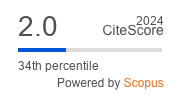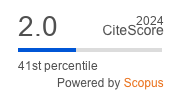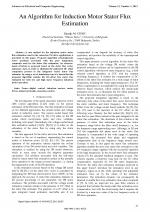| 3/2012 - 7 |
An Algorithm for Induction Motor Stator Flux EstimationSTOJIC, D. M. |
| Extra paper information in |
| Click to see author's profile in |
| Download PDF |
Author keywords
digital control, induction motors, motor drives, numerical models, sensorless control
References keywords
induction(23), flux(21), sensor(17), control(14), motors(11), electronics(10), stator(9), motor(9), speed(8), power(6)
Blue keywords are present in both the references section and the paper title.
About this article
Date of Publication: 2012-08-31
Volume 12, Issue 3, Year 2012, On page(s): 47 - 52
ISSN: 1582-7445, e-ISSN: 1844-7600
Digital Object Identifier: 10.4316/AECE.2012.03007
Web of Science Accession Number: 000308290500007
SCOPUS ID: 84865848529
Abstract
A new method for the induction motor stator flux estimation used in the sensorless IM drive applications is presented in this paper. Proposed algorithm advantageously solves problems associated with the pure integration, commonly used for the stator flux estimation. An observer-based structure is proposed based on the stator flux vector stationary state, in order to eliminate the undesired DC offset component present in the integrator based stator flux estimates. By using a set of simulation runs it is shown that the proposed algorithm enables the DC-offset free stator flux estimated for both low and high stator frequency induction motor operation. |
| References | | | Cited By «-- Click to see who has cited this paper |
| [1] L. Zhen, and L. Xu, "Sensorless field orientation control of induction machines based on a mutual MRAS scheme," IEEE Transactions on Industrial Electronics, vol. 45, pp. 824-831, 1998. [CrossRef] [Web of Science Times Cited 107] [SCOPUS Times Cited 150] [2] M. Tsuji, and S. Chen, "A sensorless vector control system for induction motors using q-axis flux with stator resistance identification," IEEE Transactions on Industrial Electronics, vol. 48, pp. 185-190, 2001. [CrossRef] [Web of Science Times Cited 74] [SCOPUS Times Cited 117] [3] H. Tajima, and Y. Hori, "Speed sensorless field oriented control of the Induction machine," Proceedings of the IEEE Conference IEEE-LAS'91, pp. 385-391, 1991. [4] B. K. Bose, and N. R. Patel, "A programmable cascaded low-pass filter-based flux synthesis for a stator flux-oriented vector-controlled induction motor drive," IEEE Transactions on Industrial Electronics, vol. 44, pp. 140-143, 1997. [CrossRef] [Web of Science Times Cited 101] [SCOPUS Times Cited 142] [5] J. Hu, and B. Wu, "New integration algorithm for estimating motor flux over wide speed range," IEEE Transactions on Power Electronics, vol. 13, pp. 969-977, 1998. [CrossRef] [Web of Science Times Cited 377] [SCOPUS Times Cited 596] [6] K. D. Hurst, T. G. Habetler, G. Griva, F. Profumo, and P. L. Jansen, "A self tuning closed-loop flux observer for sensorless torque control of standard induction machines," IEEE Transactions on Power Electronics, vol. 12, pp. 807-816, 1997. [CrossRef] [Web of Science Times Cited 29] [SCOPUS Times Cited 33] [7] Ogata, K., "Modern Control Engineering", Prentice-Hall, Englewood Cliffs, N.J., 2010 [8] M. Shin, D. Hyun, and S. Cho, "An improved stator flux estimation for speed sensorless stator flux orientation control of induction motors," IEEE Transactions on Power Electronics, vol. 15, pp. 312-318, 2000. [CrossRef] [Web of Science Times Cited 190] [SCOPUS Times Cited 265] [9] B. Karanayil, M. F. Rahman, and C. Grantham, "An implementation of a programmable cascaded low-pass filter for a rotor flux synthesizer for an induction motor drive," IEEE Transactions on Power Electronics, vol. 19, pp. 257 - 263, 2004. [CrossRef] [Web of Science Times Cited 37] [SCOPUS Times Cited 64] [10] M. Hinkkanen, "Analysis and design of full-order flux observers for sensorless induction motors," IEEE Transactions on Industrial Electronics, vol. 51, pp. 1033 - 1040, 2004. [CrossRef] [Web of Science Times Cited 93] [SCOPUS Times Cited 136] [11] M. H. Shin, D. S. Hyun, S. B. Cho, and S. Y. Choe, "An improved stator flux estimation for speed sensorless stator flux orientation control of induction motors," IEEE Trans. Power Electron., vol. 15, pp. 312-318, 2000. [CrossRef] [Web of Science Times Cited 190] [SCOPUS Times Cited 265] [12] J. Holtz, "Sensorless control of induction motor drives," Proc. IEEE, 2000, vol. 90, pp. 1359-1383, Aug. 2002. [CrossRef] [Web of Science Times Cited 525] [SCOPUS Times Cited 708] [13] J. Holtz and J. Quan, "Drift and parameter-compensated flux estimator for persistent zero-stator-frequency operation of sensorless-controlled induction motors," IEEE Trans. Ind. Appl., vol. 39, pp. 1052-1060, 2003. [CrossRef] [Web of Science Times Cited 243] [SCOPUS Times Cited 313] [14] B. Karanayil, M. F. Rahman, and C. Grantham, "An implementation of a programmable cascaded low-pass filter for a rotor flux synthesizer for an induction motor drive," IEEE Trans. Power Electron., vol. 19, no. 2, pp. 257-263, 2004. [CrossRef] [Web of Science Times Cited 37] [SCOPUS Times Cited 64] [15] J. Holtz, J. Quan, "Sensorless vector control of induction motors at very low speed using a nonlinear inverter model and parameter identification," IEEE Trans. Ind. Applicat., vol. 38, pp. 1087-1095, 2002. [CrossRef] [Web of Science Times Cited 302] [SCOPUS Times Cited 387] [16] H. Kubota, I. Sato, Y. Tamura, K. Matsuse, H. Ohta, H, and Y. Hori, "Regenerating-mode low-speed operation of sensorless induction motor drive with adaptive observer." IEEE Trans. Ind. Applicat., vol. 38, pp. 1081-1086, 2002. [CrossRef] [Web of Science Times Cited 167] [SCOPUS Times Cited 215] [17] J. Maes, and J. Melkebeek, "Speed-sensorless direct torque control of Induction motors using an adaptive flux observer" IEEE Trans. Ind. Applicat., vol. 36, pp. 778-785, 2000. [CrossRef] [Web of Science Times Cited 279] [SCOPUS Times Cited 364] [18] M. Hinkkanen, and J. Luomi, "Modified integrator for voltage model Flux estimation of induction motors," IEEE Trans. Ind. Electron., vol. 50, pp. 818-820, 2003. [CrossRef] [Web of Science Times Cited 114] [SCOPUS Times Cited 160] [19] M. Hinkkanen, "Analysis and design of full-order flux observers for sensorless induction motors," IEEE Trans. Ind. Electron., vol. 51, pp. 1033-1040, 2004. [CrossRef] [Web of Science Times Cited 93] [SCOPUS Times Cited 136] [20] M. Hinkkanen, and J. Luomi, "Stabilization of regenerating-mode Operation in sensorless induction motor drives by full-order flux observer design," IEEE Trans.Ind. Electron., vol. 51, pp. 1318-1328, 2004. [CrossRef] [Web of Science Times Cited 93] [SCOPUS Times Cited 136] [21] M. Hinkkanen, V. Leppanen, and J. Luomi, "Flux observer enhanced with low-frequency signal injection allowing sensorless zero-frequency operation of induction motors," IEEE Trans. Ind. Applicat., vol. 41, pp. 1160-1156, 2005. [CrossRef] [Web of Science Times Cited 45] [SCOPUS Times Cited 61] [22] S. Gadoue, D. Giaouris, and J. Finch, "Sensorless control of induction motor drives at very low and zero speeds using neural network flux observers," IEEE Transactions on Industrial Electronics, vol. 56, pp. 3029-3039, 2009. [CrossRef] [Web of Science Times Cited 100] [SCOPUS Times Cited 155] [23] M. Comanescu, L. Xu, "An improved flux observer based on PLL frequency estimator for sensorless vector control of induction motors," IEEE Transactions on Industrial Electronics, 53, pp. 53-56, 2006. [CrossRef] [Web of Science Times Cited 118] [SCOPUS Times Cited 173] [24] I. Nik, and Y. Abdul, "An improved stator flux estimation in steady- state operation for direct torque control of induction machines," IEEE Transactions on Industry Applications, vol. 38, pp. 110-116, 2002. [CrossRef] [Web of Science Times Cited 128] [SCOPUS Times Cited 214] [25] F. Zidani, D. Diallo, M. Benbouzid, and R. Nait-Said, "Direct torque control of induction motor with fuzzy stator resistance adaptation," IEEE Transactions on Energy Conversion, vol. 21, pp. 619-621, 2006. [CrossRef] [Web of Science Times Cited 33] [SCOPUS Times Cited 43] [26] C. Veganzones, and F. Blazquez, "Adaptation of floating point DSP- based technology for small variable-speed wind turbine," IEEE Transactions on Energy Conversion, vol. 22, pp. 376-382, 2007. [CrossRef] [Web of Science Times Cited 10] [SCOPUS Times Cited 14] Web of Science® Citations for all references: 3,485 TCR SCOPUS® Citations for all references: 4,911 TCR Web of Science® Average Citations per reference: 134 ACR SCOPUS® Average Citations per reference: 189 ACR TCR = Total Citations for References / ACR = Average Citations per Reference We introduced in 2010 - for the first time in scientific publishing, the term "References Weight", as a quantitative indication of the quality ... Read more Citations for references updated on 2025-05-30 16:52 in 161 seconds. Note1: Web of Science® is a registered trademark of Clarivate Analytics. Note2: SCOPUS® is a registered trademark of Elsevier B.V. Disclaimer: All queries to the respective databases were made by using the DOI record of every reference (where available). Due to technical problems beyond our control, the information is not always accurate. Please use the CrossRef link to visit the respective publisher site. |
Faculty of Electrical Engineering and Computer Science
Stefan cel Mare University of Suceava, Romania
All rights reserved: Advances in Electrical and Computer Engineering is a registered trademark of the Stefan cel Mare University of Suceava. No part of this publication may be reproduced, stored in a retrieval system, photocopied, recorded or archived, without the written permission from the Editor. When authors submit their papers for publication, they agree that the copyright for their article be transferred to the Faculty of Electrical Engineering and Computer Science, Stefan cel Mare University of Suceava, Romania, if and only if the articles are accepted for publication. The copyright covers the exclusive rights to reproduce and distribute the article, including reprints and translations.
Permission for other use: The copyright owner's consent does not extend to copying for general distribution, for promotion, for creating new works, or for resale. Specific written permission must be obtained from the Editor for such copying. Direct linking to files hosted on this website is strictly prohibited.
Disclaimer: Whilst every effort is made by the publishers and editorial board to see that no inaccurate or misleading data, opinions or statements appear in this journal, they wish to make it clear that all information and opinions formulated in the articles, as well as linguistic accuracy, are the sole responsibility of the author.



